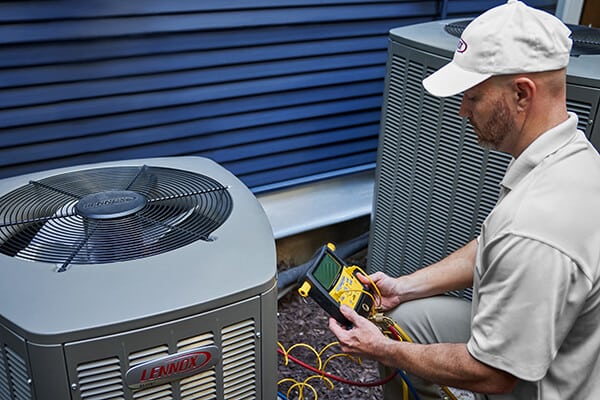
Throughout sweltering summers, our air conditioners work tirelessly to keep us comfortable. So, it’s no surprise that when they break down we feel distressed and concerned. One of the most common AC problems is water leakage. While a small amount of water condensation is normal, pooled water around your air conditioning unit is not. Here are some of the reasons why your AC might be leaking and how to correct them.
1. Clogged Condensate Drain Line
When the air conditioner is running, it produces condensation as a by-product of the cooling process. This condensation collects in a pan and is drained away through a small pipe. However, over time, this pipe can become clogged with dirt, dust, and other debris. As a result, the water has nowhere to go and begins to leak out of the air conditioner. In some cases, the leak can be severe enough to cause water damage to your home.
One method for cleaning clogged condensate lines is to use a plumbing snake to break up blockage in the line to allow proper flow of water from the AC system. You can also remove any debris from the outside area around your unit, since some clogs may start on the outside before spreading inside the line itself. Regular maintenance of your AC system is also an important way to prevent buildup and clogging in your drain line.
2. Disconnected Drain Line
The drain line is a critical component of an air conditioning unit since it collects water runoff from various parts of the appliance. A disconnected drain line can cause expensive damage to your AC, from water buildup in the compressor to corrosion of internal components and overheating. Additionally, a malfunctioning drain line can cause leaks throughout your building, resulting in costly repairs.
There are several ways to fix a disconnected drain line. The most common approach is to simply run a new drain line from the air conditioner to the nearest outlet. If this approach is not feasible, you can also use an epoxy sealant to patch and repair any existing connections. This works particularly well in cases where the disconnection has occurred at a joint rather than at the actual attachment point.
3. Broken Evaporator Coil
Evaporator coils are located in the central unit of the AC system, and they play an essential role in maintaining the proper temperature inside your home. When these coils become damaged or worn out, they can no longer effectively perform their function. As a result, the entire AC system is put under strain, causing it to work harder and leak more frequently. There are several factors that contribute to broken evaporator coils, including age and wear, excessive use, fluctuations in temperature, and improper installation.
Despite these challenges, there are steps you can take to maintain your evaporator coils and prevent them from breaking down prematurely. This might include regular cleaning and inspections or installing protective coverings over the coil surface.
4. Dirty Air Filter
The air filter is responsible for trapping dirt, dust, and other airborne contaminants, and over time, it can become clogged with debris. If your air filter is dirty, it will restrict airflow to your AC unit, causing it to work harder to cool your home. This can lead to a buildup of condensation on the evaporator coils, which can eventually cause the coils to freeze and leak water.
To prevent this from happening, be sure to check your air filter regularly and replace it when necessary. If you have a reusable air filter, simply rinse it off with water and allow it to dry completely before putting it back in place. If you have a disposable air filter, be sure to replace it according to the manufacturer’s recommendations.
5. Corroded/Damaged Drip Pan
This collection tray sits below the evaporator coils and collects any water or condensation that drips from the coils. If the drip pan is damaged or corroded, it can lead to leaks in your AC system, which can in turn cause damage to other parts of your unit as well as create costly repairs.
There are a few key reasons why a corroded or damaged drip pan is such a major contributor to AC leakage. To begin with, condensation from the evaporator coils typically contains contaminants like dust and dirt, so when this liquid falls into a corroded drip pan, it produces even more rust and corrosion that can quickly degrade the tray’s material. Additionally, because condensation builds up over time, even a seemingly small leak in your drip pan can quickly become a much bigger problem if left unchecked.
To prevent this issue, it is essential to regularly check and maintain the drip pan. You should clean this component on a regular basis, making sure to get into all corners and crevices in order to flush out any hidden buildup.
6. Outdoor Temperature Is Too Cold to Run the AC
AC units are designed to operate in warm weather, and when the outdoor temperature dips below 60 degrees Fahrenheit, the unit can begin to freeze up. The ice then melts and drips, causing a leak. In some cases, the ice can also cause the AC unit to malfunction, leading to even more extensive damage.
Even in our area, the winters can occasionally be quite cold, and some steps can be taken to protect your AC unit. One way to do this is to invest in a weatherproof cover. You should also avoid using your AC unit when the temperature is below 60 degrees. Wait until the temperature rises before turning on your AC again.
7. Low Refrigerant Level
Refrigerant is a fluid that moves through the system, circulating heat through evaporator coils and out of your home. When its level drops too low, leaks can form in the various components of the AC. There are several factors that can contribute to low refrigerant levels, including improper installation or old age. Additionally, frequent temperature fluctuations can cause the refrigerant to expand or contract and seep out through tiny cracks in the AC unit, resulting in reduced efficiency and higher energy bills. Finally, exposure to extreme heat or cold can also compromise refrigerant levels, since it affects both the liquid and gas phases of the refrigerant.
To prevent low refrigerant levels, it is important to inspect your air conditioner regularly. This may include checking the insulation around exposed coils or noticing an increase in energy bills that doesn’t seem to correlate with your usage. You should also schedule regular maintenance sessions with a professional HVAC technician who can inspect your system for potential issues and perform any necessary repairs or replacements as needed.
Your Local HVAC Professionals
At McGowan's Heating & Air Conditioning, we are dedicated to providing top-quality heating and air conditioning services to the residents of Bunnell, Jacksonville, and all of Northeast Florida to Daytona Beach. That includes installation, repair, and maintenance. Whether you need reliable indoor air quality solutions, expert duct cleaning services, new construction installations, or commercial solutions, we have the expertise to get the job done right. Contact us today to learn more about our services or to schedule an appointment.



